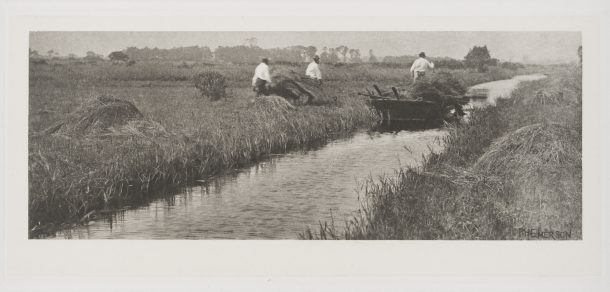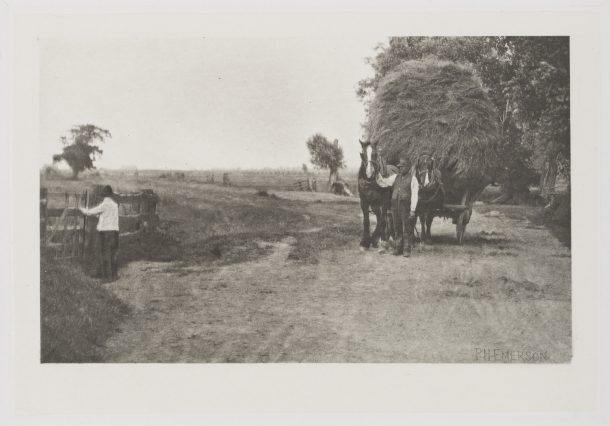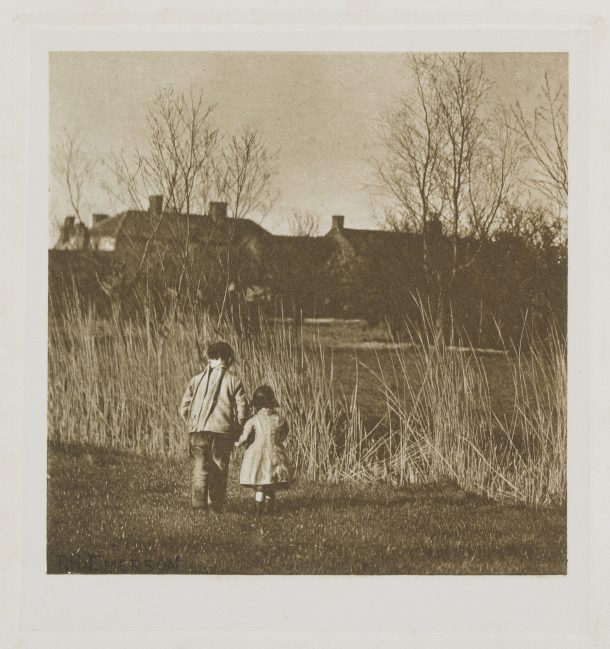With the national lockdown now back upon us, many people will be increasing the amount of walks they take together again as a household. Over the last few months, it has been well documented how many have found solace reconnecting with nature and experiencing their local surroundings anew, at a slower pace.
The wish to reconnect with nature has perhaps been a stronger one than many of us knew we possessed. Though the circumstances bringing this realisation may be unprecedented (and distressing), the urge is not a new one. The book collections at the National Art Library of the V&A conjure up their own pieces of evidence from the past.
In 1887 the photographer Peter Henry Emerson (1856-1936) published the work ‘Idyls of the Norfolk Broads: being twelve autogravure plates from original negatives, together with descriptive text and introductory’. Emerson chose to tell the stories and evoke the ambience of a more rural existence fast disappearing with the rapid progression of the Industrial Revolution throughout Great Britain.
Wandering in early spring, on a marsh rich with flowers, two village children have spied a field-mouse which has quickly disappeared, running into the slight hedge formed by the thin growth of last year’s battered reed.
Peter Henry Emerson
Shown are some of the practices in which villagers in the Norfolk Broads region engaged to provide their incomes and way of life. The area became popular with tourists during the late 19th century as it brought a pronounced contrast to the urban existence of many.

38041800888539. © Victoria and Albert Museum
Pictorialism as a movement began in the 1880s and reached the height of its influence between 1890 and World War I. Two routes for photography were explored within the art critic, Charles Caffin’s 1901 book Photography as a Fine Art : ‘one being a record of facts, and the other an expression of beauty’. Emerson did not pursue the doctoring of photos for artistic effect in the manner of the photographer Henry Peach Robinson (1830 -1901), or pose models for allegorical and illustrative studio photographs like Julia Margaret Cameron (1815-1879). He did, however, promote the idea that photography should capture an accurate rendition of an image captured by a human eye: with a crisp focal point progressing to less definition around the edges.

Artists grouped within the pictorialist spectrum looked towards painting and literature as a guide for the subject matter and finish of their photographs. Emerson was not interested in the utilitarian implementation of photography to record facts. His work does attempt to capture, however, a sense of the true landscape and traditional practices of the area. He spent time absorbing the lifestyles of those who lived in the Norfolk Broads region. He lived and collaborated with the artist Thomas Goodall (1856-1944), who had married and settled in the area, living for at least ten years on a houseboat at South Walsham Broads.
The portfolio of prints (proof no.10) was presented to the Library by Emerson in 1888. With the accompanying expressive notes for each photograph, it presents a beautiful way of experiencing a series of “moments” frozen in time. Of course, these plates could be hung on the wall and rotated occasionally to follow the seasons covered. Perhaps some of our own snapshots from lockdown walks could serve a similar purpose, reminding us of the year round beauty present just round the corner, when we have a moment to appreciate it.
In the process of reproduction, no retouching has marred the subtleties of Nature’s handiwork, for the plates are the result of a chemical process…
Introduction, x, Peter Henry Emerson
At present, the National Art Library remains closed to the public. In the meantime, from 16 November 2020, we look forward to taking your enquiries and copying requests online.



